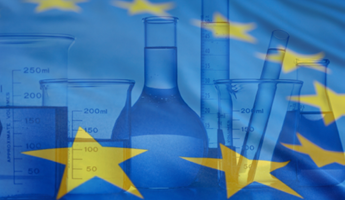Kemikaliestrategi för hållbarhet
-
Aktuella vetenskapliga ämnen
- Förebygga cancer
- Hudsensibiliserande kemikalier
- Per- och polyfluoralkylsubstanser (PFAS)
- Mikroplaster
- Granulat och täckmaterial på gräsplaner
- Tatueringsbläck och permanent makeup
- Glyfosat
- Hormonstörande ämnen
- Bisfenoler
- Kemikaliestrategi för hållbarhet
- Djurförsök enligt Reach
- Ftalater
- Biocides
- Bly
- Research to enhance protection of our health and environment
Kemikaliestrategi för hållbarhet

Europeiska kommissionen antog sin kemikaliestrategi för hållbarhet den 14 oktober 2020. Strategin är en del av EU:s ambition om nollutsläpp, ett viktigt åtagande inom den europeiska gröna given, som syftar till att bättre skydda medborgarna och miljön mot skadliga kemikalier samt påskynda innovation genom att främja användning av säkrare och hållbarare kemikalier.
Den europeiska gröna given är EU:s nya tillväxtstrategi. Europa ska genom den ställas om till en hållbar och koldioxidneutral ekonomi samtidigt som den ekonomiska krisen och konsekvenserna av covid-19 åtgärdas.
Kemikalier är byggstenarna i de varor vi använder och i de högteknologiska material som behövs för en cirkulär och klimatneutral ekonomi. Kemikalieproduktionen är också en energi- och koldioxidintensiv industrisektor. En övergång till kemikalier och mindre energikrävande produktionsteknik kommer att begränsa utsläppen, vilket betyder att den gröna given är i behov av ”rätt” kemi.
Echa bidrar, som EU:s specialiserade byrå, till denna strategi med sin vetenskapliga och rättsliga expertkompetens, sina databaser, digitala verktyg och nätverk samt praktiska erfarenheter av kemikalielagstiftning när så efterfrågas.
Echas eget löfte, som EU-organisation och arbetsgivare, vad gäller den europeiska gröna given är att utöka sin miljöcertifiering med EU:s miljölednings- och miljörevisionsordning (Emas) och bli klimatneutralt senast 2030.
The Commission’s strategy provides an action plan to:
- Ban the most harmful chemicals in consumer products – allowing those chemicals only where their use is essential.
- Pay attention to the cocktail effect of chemicals when assessing chemical risks.
- Phase out per- and polyfluoroalkyl substances (PFAS) in the EU, unless their use is essential.
- Boost investment and innovative capacity for the production and use of chemicals that are safe and sustainable by design throughout their lifecycle.
- Promote the EU’s supply and sustainability of critical chemicals.
- Establish a simpler “one substance, one assessment” process for assessing the risks and hazards of chemicals.
- Play a leading role globally by championing and promoting high chemical safety standards and not exporting chemicals banned in the EU.
The Commission has asked ECHA to take an active role in the following work areas:
- Developing criteria for chemicals that are safe and sustainable by design.
- Assessing how to introduce mixture assessment factors in REACH.
- Establishing a “one substance, one assessment” process to coordinate hazard and risk assessment across chemicals legislation.
- Developing an indicator framework on chemicals as part of the Zero Pollution and 8th Environment Action Programme monitoring framework.
- Improving enforcement of chemicals legislation.
- Developing a strategic research and innovation agenda for chemicals.
- Developing EU-wide human and environmental biomonitoring in the context of the Partnership for the Assessment of Risk from Chemicals (PARC).
- Establishing an EU chemical early warning and action system.
In addition, ECHA will provide scientific and technical support for the impact assessment on planned revisions to REACH and CLP.
REACH revision
ECHA will support the amendment of REACH information requirements for substances that have critical hazard properties. The Agency is also involved in preparatory work for extending the registration duty to certain polymers, which currently do not need to be registered under REACH.
The Agency is a member in steering groups for studies and assessments on:
- information on volumes, uses, exposure/emissions and environmental footprint in REACH registrations;
- derived minimal effect levels (DMELs) for certain substances; and
- introducing a mixture assessment factor.
To improve the evaluation of chemicals, ECHA will provide information on the functioning of dossier and substance evaluation to the Commission with proposals to develop the two processes further.
To develop the use of the generic approach to risk management, ECHA will gather information on uses of certain hazardous substances. It will furthermore support the Commission in developing options to reform authorisation and restrictions. Additionally, the Agency will contribute to the development of criteria for essential uses of substances.
Until the generic approach to risk management is introduced and applicable in REACH, ECHA supports the development of criteria for prioritising substances and groups of substances for restrictions to establish a restrictions roadmap.
CLP revision
ECHA will assist the Commission in revising and developing new hazard criteria under the CLP Regulation for:
- persistent, mobile and toxic (PMT) and very persistent and very mobile substances (vPvM);
- terrestrial organisms;
- immunotoxicity and developmental neurotoxicity;
- endocrine disrupters; and
- persistent, bioaccumulative and toxic (PBT) and very persistent, very bioaccumulative substances (vPvB).
The Agency will assess the information it has available to identify substances that qualify for the new and further hazard classes or criteria and, where possible, set up a list of these substances.
European Commission
- Chemicals Strategy for Sustainability [PDF]
- Chemicals Strategy - background
- Chemicals Strategy implementation
- European Green Deal
- Commission's note to agencies on chemicals strategy 21 December 2020 [PDF]
- Commission's request to ECHA on chemicals strategy 12 April 2021 [PDF]
- Restrictions Roadmap
ECHA
- CLP Revision - ECHA input [PDF]
- ECHA's contributions to CSS work in 2023 [PDF]
- ECHA's contributions to CSS work in 2022 [PDF]
- ECHA's contributions to CSS work in 2021 [PDF]
- ECHA’s contribution to the Commission’s Restrictions Roadmap [PDF]
- ECHA news release 14 October 2020 - ECHA ready to help the EU achieve its ambitions for safe and sustainable chemicals


